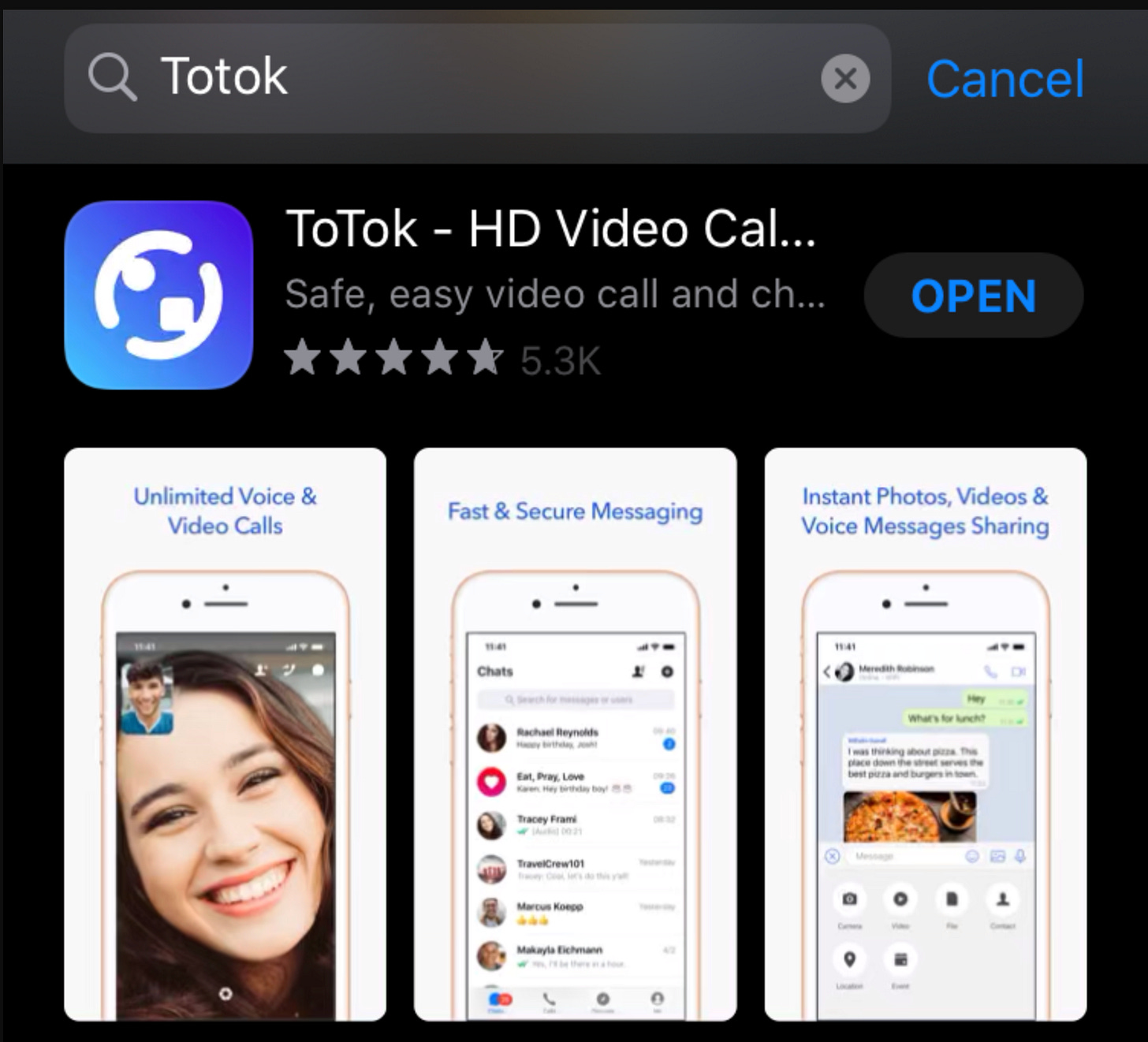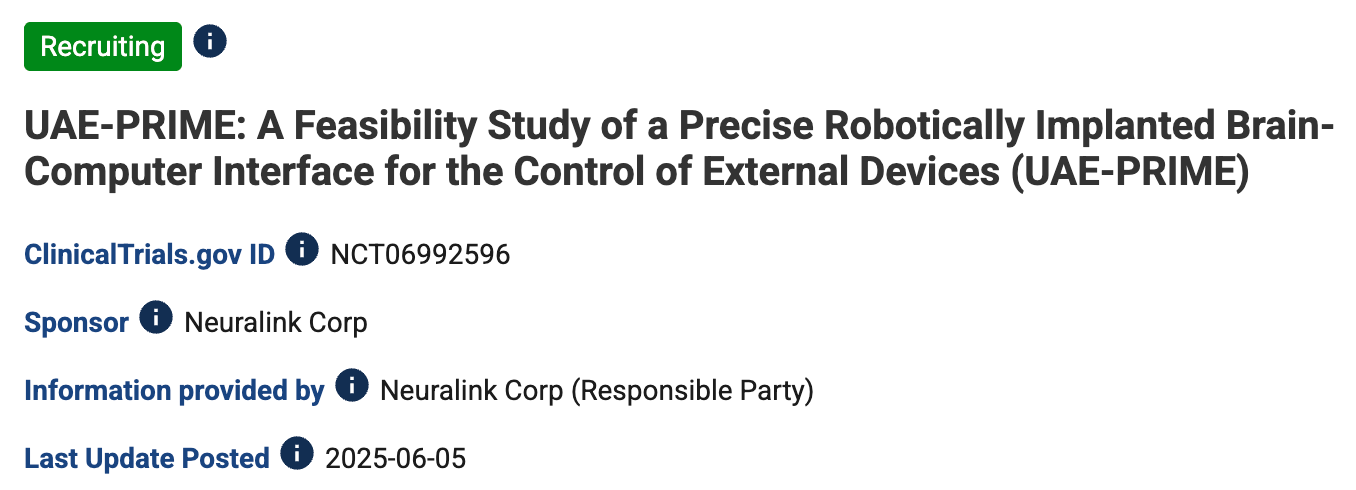RJ is a US military veteran, paralyzed from a spinal cord injury. In April 2025, he received a Neuralink brain implant at the University of Miami. Right now, there’s a device in his skull recording his thoughts continuously — neural patterns that might contain military training, combat experience, classified knowledge embedded in the way his brain has been shaped by years of service.
The company that put it there, that’s collecting and processing RJ’s brain data, just took hundreds of millions of dollars from a foreign intelligence official.
I wish I was exaggerating.
The $650 Million Question
In May 2025, Neuralink raised $650 million in their Series E funding round. At the time, they had exactly five people with brain implants. By the time I’m writing this in November, they’re up to thirteen.
That’s a staggering amount of money for a company that’s still figuring out if their technology is even safe long term. We know it works in the sense that patients can control computers with their thoughts. That part is real and genuinely impressive. But we don’t have comprehensive trial results. We don’t have long-term safety data. We don’t have the kind of peer-reviewed, published research you’d normally see before investors drop this kind of cash.
So I needed to understand: who’s writing these checks? And more importantly, why are they writing them now?
Because here’s what I’ve learned after four parts of digging into Neuralink: the patients will show you what the chip can do. But it’s the investors that will show you what the chip is meant to do.
The Corporate Shell Game
When I started pulling SEC filings for Neuralink’s Series E round, I expected to see straightforward investor names listed in standard corporate documentation. Founders Fund putting in money from their usual fund. Sequoia Capital investing through Sequoia Capital Fund XII or whatever their current active fund happens to be. Maybe some sovereign wealth funds listed directly by their official names. Standard venture capital paperwork that any researcher could follow and verify.
What I found instead was something I’d genuinely never encountered before in ten years of investigating corporate structures and following money through regulatory filings.
The Series E wasn’t funded by investors writing checks from their normal, established funds using their standard legal entities. Instead, the documentation revealed a genuinely bewildering maze of specially created investment vehicles, each one structured as its own separate legal entity with its own registration. Eagle VP Fund 2 Series Neuralink. AC Ventures LLC Series Neuralink 1. Multiple entities with names like “Neuralink 2025 Series” followed by different identifying numbers. On and on, each one apparently created specifically for this single investment.
This is not how normal venture capital works, and I want to be very clear about that because it’s important to understand just how unusual this structure actually is. When Sequoia invests in a company, they write a check from Sequoia Capital Fund XII or whatever their active fund is at the time. One fund, one investment, clean and traceable documentation that any researcher can follow. They don’t create an entirely new legal entity with a unique name just for that single deal. It would be absurdly inefficient and pointlessly complicated for no apparent benefit.
But Neuralink’s Series E appears to involve at least a dozen separately registered entities, many of them created specifically and exclusively for this funding round according to the dates on their formation documents.
So why would Neuralink’s investors demand this level of legal separation and structural complexity? I can think of three possible explanations, and none of them are particularly reassuring when you think through the implications.
First possibility: customized deal terms that other investors cannot see. If each investor has their own separate legal entity, they can negotiate completely individual agreements with different information rights, different access to research data, different governance provisions. When certain foreign entities invest through one structure and others through different structures, we have no way to know if they negotiated radically different access to neural data than domestic investors received. The complexity makes transparency impossible.
Second possibility: liability protection and risk compartmentalization. Separate legal entities mean separate liability exposure. If something catastrophic happens— a massive data breach, serious patient harm, foreign governments gaining access to classified information embedded in veterans’ neural patterns — each investment vehicle can claim it’s a completely separate entity with separate accountability. The lawsuits become exponentially more complicated because plaintiffs have to figure out which specific entity to sue and how to prove connections between them.
Third possibility: deliberate regulatory avoidance through fragmentation. CFIUS reviews foreign investment when it crosses certain ownership thresholds. But if you fragment one large investment across multiple separate legal entities, each entity might fall well below mandatory review thresholds. Instead of “G42 owns 8% of Neuralink,” which might trigger scrutiny, you get multiple affiliated entities each owning smaller percentages. Suddenly it looks like a scattered collection of small passive investments rather than one coordinated foreign stake that should require security review.
I don’t know with certainty which of these explanations is correct. But I know this much: when you’re investing in a company that reads and decodes human thoughts in real time, that has experimental devices implanted in the brains of military veterans, that’s collecting neural data which could theoretically contain classified knowledge or sensitive military training information, the absolute last thing you want is a corporate structure that’s been specifically designed to obscure who actually owns what and who has access to what kinds of information.
And yet that’s exactly, precisely what we have.
Want to invest without the shell companies and foreign intelligence officials? Join The Rough Rider tier for $5/month! (I promise the only thing I’m surveilling is SEC filings)
The Money You’d Expect
Most of Neuralink’s investor list makes complete sense if you understand how the Elon Musk universe operates.
Peter Thiel’s Founders Fund has been backing Neuralink since the beginning. Thiel and Musk go back to the PayPal days, part of that “PayPal Mafia” that went on to build or fund half of Silicon Valley. But there’s a reason Founders Fund is interested beyond just loyalty. Thiel also founded Palantir Technologies, which makes surveillance software for the CIA, NSA, FBI, and Department of Defense. The company is literally named after the seeing stones in Lord of the Rings that let you spy on people from thousands of miles away.
Founders Fund doesn’t invest randomly. They focus on what they call “hard power” technology. Defense systems. Intelligence infrastructure. Things that give you actual control over information and people. A device that can read and decode human thoughts fits that thesis perfectly.
Valor Equity Partners follows Musk from company to company. Run by Antonio Gracias, who sits on Tesla’s board. Standard ecosystem money betting on Musk’s ability to take things public at massive valuations. And right now that’s a decent bet, considering he just became the first person in history to hit a net worth over $400 billion.
Then the usual Silicon Valley suspects: Sequoia Capital, ARK Investment Management, Lightspeed Venture Partners. These firms specialize in late-stage investing, showing up 12 to 18 months before a company goes public to position themselves for the IPO pop. Their presence tells you Neuralink is probably planning to hit the stock market sometime in 2026 or 2027.
So basically it’s a bunch of tech investors betting on Musk, pre-IPO speculators, and surveillance software veterans seeing the obvious application. Nothing exactly shocking here.
And then I saw two names that made me open about fifteen browser tabs at once.
Qatar Investment Authority
And G42
The New Oil Rush
Sovereign wealth funds investing in American tech companies is pretty normal at this point. Qatar and UAE funds have stakes in Uber, SpaceX, major real estate. Oil-rich nations diversifying into technology as they plan for a future where fossil fuels matter less. Data is the new oil, so naturally the countries with the old oil want the new oil.
But I kept digging anyway, because something felt off about the timing and the amounts involved.

Qatar Investment Authority is straightforward. It’s Qatar’s sovereign wealth fund, managing about $475 billion in assets. When they invest, it’s strategic. National interests. Geopolitical positioning. Access to emerging technology.
Qatar is a complicated American ally. They host Al Udeid Air Base, one of the largest US military installations in the Middle East. They’re also a country where homosexuality is punishable by death and political dissidents disappear into prisons. Not exactly a beacon of human rights, but their investment patterns are at least predictable.
G42 is… complicated.
On paper, G42 is an “AI and cloud computing company” based in Abu Dhabi. Their marketing materials talk about artificial intelligence infrastructure, smart cities, healthcare innovation. They sound like every other tech company trying to ride the AI wave.
But G42 is chaired by Sheikh Tahnoun bin Zayed Al Nahyan, who currently serves as the UAE’s National Security Advisor. Not former intelligence official turned businessman. His actual day job is running the UAE’s intelligence and national security operations.

So when G42 negotiates investment terms, the person at the top of that organization is someone whose entire professional life revolves around collecting information that advances intelligence interests for a foreign government.
That made me want to understand what G42 has actually done as a company. Because maybe they’re just a normal tech firm that happens to have a government official as chairman. Maybe the concerns are overblown.
They’re not overblown.
What G42 Actually Does
In December 2019, The New York Times exposed an app called ToTok. It had been downloaded millions of times across the Middle East and Asia. Just a messaging app, nothing unusual. Except according to classified intelligence documents reviewed by the Times, ToTok was a surveillance tool operated by the UAE government.
The app requested access to your microphone, camera, contacts, calendar, and location. All of that data was being sent back to servers controlled by the UAE government. Apple and Google both pulled it from their app stores once the Times investigation published.
The Times documented connections between ToTok’s parent company and G42. This wasn’t theoretical capability. This was actual mass surveillance of millions of people, deployed by an entity connected to the company now investing in brain chips.
Improving Chinese Military Weapons
In October 2022, The Financial Times reported that US intelligence agencies discovered G42 had provided flight software technology to Huawei, the Chinese telecommunications company banned in the US for national security reasons.
The software allegedly improved Chinese military air-to-air missile systems. Increased their range and ability to evade electronic countermeasures by 20 to 30 percent.
G42 allegedly helped China build better weapons to shoot down American aircraft. And they did it by providing technology to a company the US government explicitly identified as a threat to national security.
The Congressional Investigation
By January 2024, the US House Select Committee on the Chinese Communist Party had seen enough. They formally requested the Department of Commerce investigate G42, citing the company’s relationships with entities on the US government’s blacklist. Huawei. Beijing Genomics Institute, identified by the Defense Department as a Chinese military entity collecting genetic data on Americans.
This was Congress officially raising alarms about whether G42 poses a national security threat.
G42 & The IDF
And then in 2021, G42 partnered with Israeli defense contractors to create Presight.AI. Their partners included Rafael Advanced Defense Systems (makers of Israel’s Iron Dome) and Israel Aerospace Industries, one of Israel’s largest defense manufacturers.
Suddenly G42 was helping Israeli defense systems. Sharing technology with one of America’s closest allies. And just like that, the congressional investigation that had been building momentum quietly faded. The concerns about Chinese military technology were still documented, still real. But now G42 had an Iron Dome partnership, and apparently that’s all it takes.
They knew exactly what would make American politicians look the other way.
Look at the pattern. G42 takes advanced technology and channels it into military and intelligence applications for multiple countries. UAE surveillance. Chinese missiles. Israeli weapons. They don’t just invest and wait for returns. They actively integrate technology into intelligence and defense infrastructure.
And now they’re investors in a company that reads brain signals and decodes human thoughts.
At this point I’m thinking: this seems bad. But maybe it’s just opportunistic investment in cutting-edge technology. Maybe there’s no deeper coordination.
And then I looked at when everything happened.
The Timeline
May 8, 2025: The US Treasury Department announces a “Known Investor Fast-Track Pilot Program” for foreign investors wanting to put money into sensitive American technologies, including artificial intelligence and biotechnology.
The Treasury specifically names the UAE and Saudi Arabia as countries whose investors qualify for expedited review. What normally takes months through CFIUS (the Committee on Foreign Investment in the United States) can now be approved in weeks.
May 13, 2025: Five days later, Neuralink announces they’re opening a clinical trial site at Cleveland Clinic Abu Dhabi. First international trial location. The announcement is sparse on details but confirms the site will be operational soon.
May 14, 2025: The very next day, President Donald Trump arrives in the United Arab Emirates for a three-day state visit. First major international trip of his second term. The White House press release specifically emphasizes “strengthening bilateral ties in technology and innovation sectors.”
Trump meets with Sheikh Mohammed bin Zayed, the UAE’s president. Who happens to be the brother of Sheikh Tahnoun, the guy who chairs G42.
June 2025: Less than a month after all of this, Neuralink closes their $650 million Series E funding round. G42 is publicly listed as an investor.
Treasury creates a UAE fast-track. Neuralink announces a UAE trial site. Trump visits the UAE. G42 invests in Neuralink. All within four weeks.
I don’t have access to the private conversations between Trump, Musk, and UAE officials. I can’t prove direct coordination with documents.
…But I do know how to read a calendar.
What Investors Get
When investors put serious money into a Series E round (typically the final round before going public), they negotiate for information rights. It’s standard venture capital practice. Major investors typically get:
Quarterly financial reports. Operational metrics. Research findings and development updates. Sometimes board observer seats where they can see everything the board sees. For most companies, this is completely normal. If you invest $50 million in a food delivery app, you want to see order volumes and customer retention.
But for Neuralink, “operational metrics” and “research findings” could mean neural data patterns. The algorithms that decode brain signals. Device performance across different patient populations. Information about how effectively the implant reads different types of thoughts.
I can’t see Neuralink’s actual investment agreements. Those are private. But if G42 negotiated standard Series E terms, they would have access to operational data about how the technology performs.
And G42 is chaired by someone whose job is running intelligence operations for a foreign government.
The Legal Gap
You might think to yourself, “HIPAA protects this data, right?” And the answer to that is… complicated.
HIPAA protects medical records held by doctors, hospitals, and insurance companies. The law was written in 1996, before anyone imagined continuous wireless brain recording. It doesn’t automatically cover medical device manufacturers, especially in research trials.
Only four states have passed laws specifically protecting neural data: California, Colorado, Montana, and Connecticut. Texas, where Neuralink’s main facility is located, has no such law. Neither does Florida, where RJ received his implant.
CFIUS is supposed to review foreign investments for national security risks. But CFIUS review is often voluntary and focuses primarily on majority ownership or direct operational control. A minority equity stake in a Series E round might not trigger mandatory review, especially if investors can argue they’re passive financial backers.
The rules around neural data simply don’t exist yet. Who can access it? What can they do with it? How long can they keep it? Can it be shared across borders? None of these questions have clear legal answers.
We’re building infrastructure for collecting brain data at scale while the laws protecting that data are nonexistent.
Where Does This Leave Us?
A foreign intelligence official chairs a company that just invested in technology recording American veterans’ thoughts. That same entity has deployed mass surveillance apps, allegedly improved Chinese military weapons, and systematically channels technology into defense applications across multiple countries.
The investment closed weeks after Treasury created a UAE fast-track program, immediately following Trump’s UAE visit, right as Neuralink announced their Abu Dhabi trial site.
The legal protections for neural data don’t exist. The corporate structure is deliberately fragmented to obscure ownership. Standard investor rights could give G42 access to operational data and research findings.
And there’s a veteran named RJ with a device in his brain right now, recording continuously.
Of course, I can’t tell you what G42 plans to do with their access.
But I know what they’ve done before. I know the infrastructure is being built behind closed doors while the laws don’t exist yet. They’re reading the mind of someone who defended freedom of speech in a country that protects it, with money from governments where speaking your mind is a crime.
It’s almost poetic.
Almost.
Sources Cited
Neuralink Funding ($650 Million Series E, 2025)
Official Neuralink announcement: https://neuralink.com/updates/neuralink-raises-650m-series-e/
TechCrunch coverage: https://techcrunch.com/2025/06/02/elon-musks-neuralink-closes-a-650m-series-e/
Neuralink Investors
Crunchbase confirmation: https://news.crunchbase.com/health-wellness-biotech/braintech-funding-semiconductors-neuralink/
Corporate Structure and SEC Filings
SEC filing for Grin (Series of CGF2021 LLC): https://www.sec.gov/edgar/search/#/ciks=0001958067&entityName=Grin%2520a%2520Series%2520of%2520CGF2021%2520LLC%2520(CIK%25200001958067)
RJ - US Military Veteran Patient
University of Miami official announcement: https://news.med.miami.edu/paralyzed-veteran-surgically-implanted-with-neuralink-device-at-the-miami-project-to-cure-paralysis/
ToTok UAE Surveillance Investigation
NYTimes Investigation: https://www.nytimes.com/2019/12/22/us/politics/totok-app-uae.html
Al Jazeera: https://www.aljazeera.com/news/2019/12/23/calling-app-totok-used-as-spying-tool-by-uae-report
Axios coverage: https://www.axios.com/2019/12/22/totok-united-arab-emirates-privacy-data-app
G42 Technology Transfer to Huawei/Chinese Military
Foundation for Defense of Democracies analysis: https://www.fdd.org/analysis/2025/10/29/new-tech-transfer-between-uae-and-china-should-throw-sand-in-the-gears-of-u-s-ai-exports-to-the-gulf/
The Week coverage: https://www.theweek.in/news/middle-east/2025/10/26/uae-allegedly-gave-china-the-key-pl-15-missile-tech-that-pakistan-used-against-india.html
Congressional Investigation of G42
House Select Committee official page - January 2024 letter: https://selectcommitteeontheccp.house.gov/media/press-releases/gallagher-calls-usg-investigate-ai-firm-g42-ties-prc-military-intelligence
House Select Committee - July 2024 follow-up: https://selectcommitteeontheccp.house.gov/media/letters/letter-nsa-microsofts-billion-dollar-partnership-uae-firm-g42
G42 Corporate Information and Leadership
Washington Institute analysis: https://www.washingtoninstitute.org/policy-analysis/g42-and-china-uae-us-triangle
Presight official website: https://www.presight.ai/
HIPAA Limitations
HHS official HIPAA - https://www.hhs.gov/hipaa/for-professionals/index.html
CFIUS Information
Treasury official CFIUS - https://home.treasury.gov/policy-issues/international/the-committee-on-foreign-investment-in-the-united-states-cfius
State Neural Data Privacy Laws
California Consumer Privacy Act amendments (2024) - AB 1008
Colorado Privacy Act neural data provisions (2024) - SB24-041
Montana neural data protection law (2025) - HB 649
Connecticut data privacy law (2025) - SB 3

















